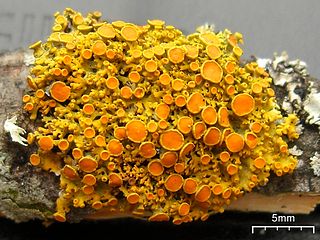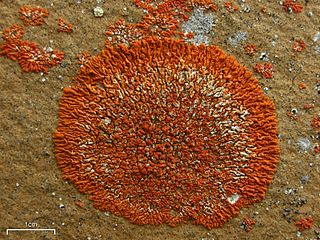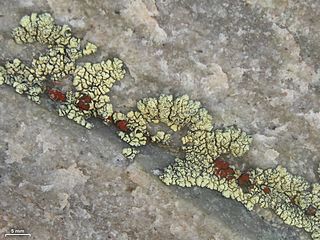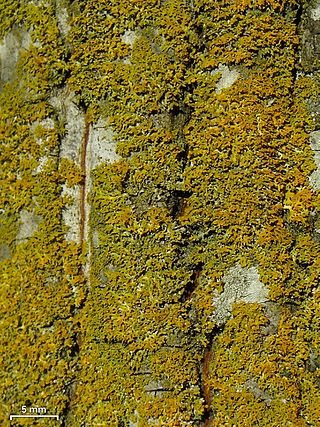
Xanthoria parietina is a foliose lichen in the family Teloschistaceae. It has wide distribution, and many common names such as common orange lichen, yellow scale, maritime sunburst lichen and shore lichen. It can be found near the shore on rocks or walls, and also on inland rocks, walls, or tree bark. It was chosen as a model organism for genomic sequencing by the US Department of Energy Joint Genome Institute (JGI).

The Teloschistaceae are a large family of mostly lichen-forming fungi belonging to the class Lecanoromycetes in the division Ascomycota. The family has a cosmopolitan distribution, although its members occur predominantly in temperate regions. Most members are lichens that either live on rock or on bark, but about 40 species are lichenicolous – meaning they are non-lichenised fungi that live on other lichens. Many members of the Teloschistaceae are readily identifiable by their vibrant orange to yellow hue, a result of their frequent anthraquinone content. The presence of these anthraquinone pigments, which confer protection from ultraviolet light, enabled this group to expand from shaded forest habitats to harsher environmental conditions of sunny and arid ecosystems during the Late Cretaceous.

Rusavskia elegans, commonly known as the elegant sunburst lichen, is a lichenized species of fungus in the genus Rusavskia, family Teloschistaceae. Recognized by its bright orange or red pigmentation, this species grows on rocks, often near bird or rodent perches. It has a circumpolar and alpine distribution. It was one of the first lichens to be used for the rock-face dating method known as lichenometry.

Xanthoria is a genus of lichenized fungi in the family Teloschistaceae. Common names include orange lichen, orange wall lichen, and sunburst lichen. They can be identified by their characteristic squamulose morphology with distinctive "fairy cups".
Gallowayella aphrodites is a species of corticolous (bark-dwelling), foliose (leafy) lichen in the family Teloschistaceae. It is found in the Mediterranean countries Greece, Cyprus, and Italy. Characteristics of the lichen include its small thallus, the disposition of the rhizines on the thallus undersurface, and the lack of vegetative propagules.
Alfred Mycolayovych Oxner was a Ukrainian botanist and lichenologist. His research covered various areas: floristics, taxonomy, phylogenetics, phytogeography, and phytosociology. Oxner founded the National Lichenological Herbarium of Ukraine.
Sergey Yakovlevich Kondratyuk is a Ukrainian botanist specialising in lichenology. His research deals with the taxonomy, floristics, ecology and geography of lichens and lichenicolous fungi. He has worked at the M.G. Kholodny Institute of Botany of National Academy of Sciences of Ukraine for more than 40 years. In 2014 Kondratyuk was awarded the State Prize of Ukraine in Science and Technology.
Capronia suijae is a species of lichenicolous fungus in the family Herpotrichiellaceae. Found in Belarus, it was formally described as a new species in 2017 by Andrei Tsurykau and Javier Etayo. The type specimen was collected from Ostrozhanka Village where it was found growing on the thallus of the bark-dwelling, crustose lichen Xanthoria parietina; Muellerella lichenicola was also simultaneously parasitizing the lichen. Capronia suijae is only known to occur at the type locality. The species epithet suijae honours Estonian lichenologist Ave Suija, "in recognition of her important contribution to the knowledge of lichenicolous fungi".

Gallowayella hasseana, the poplar sunburst lichen, is a species of corticolous (bark-dwelling), crustose lichen in the family Teloschistaceae. It occurs in North America.

Xanthoria aureola, commonly known as the seaside sunburst lichen, is a lichenized species of fungus in the family Teloschistaceae and phylum Ascomycota. X. aureola can be recognized by its bright yellow-orange pigmentation and abundant strap-shaped lobes. It is usually found growing on exposed, nutrient-rich rocks in sunny, maritime habitats. It is largely restricted to European coasts, stretching from Portugal to Norway.

Rusavskia is a genus of lichen-forming fungi in the family Teloschistaceae. It has 12 species. It is a member of the subfamily Xanthorioideae. The thallus of Rusavskia is characterized by its foliose (leaf-like) structure with distinct and typically narrow lobes that curve outwards.

Martinjahnsia is a single-species fungal genus in the family Teloschistaceae. It contains the sole species Martinjahnsia resendei, a saxicolous (rock-dwelling) crustose lichen.
Xanthoria yorkensis is a species of corticolous (bark-dwelling), crustose lichen in the family Teloschistaceae. Found in South Australia, it was formally described as a new species in 2009 by lichenologists Sergey Kondratyuk and Ingvar Kärnefelt. The type specimen, collected along the Maitland road in Yorke Peninsula, was found growing on Melaleuca trees in mallee scrub. The species epithet refers to its type locality, the only place the lichen is known to occur. Kondratyuk and colleagues proposed to transfer the taxon to the newly circumscribed Jackelixia in 2009, but this genus has not been widely accepted by other authorities.
Xanthoria kangarooensis is a species of corticolous (bark-dwelling), crustose lichen in the family Teloschistaceae. Found in Australia, it was formally described as a new species in 2009 by lichenologists Sergey Kondratyuk and Ingvar Kärnefelt. The type specimen was collected from East Kangaroo Island, where it was found growing on dead Lycium ferocissimum shrubs. Other associated lichens include species of Pyxine, Ramalina, and Rinodina. The species epithet kangarooensis refers to its type locality, the only place the lichen is known to occur. Kondratyuk and colleagues proposed to transfer the taxon to the newly circumscribed Jackelixia in 2009, but this genus has not been widely accepted by other authorities.

Erichansenia epithallina is a species of saxicolous (rock-dwelling), crustose lichen in the family Teloschistaceae. It is also a lichenicolous lichen species, meaning that it grows on other lichens. Many host genera have been recorded. It occurs in Europe and North America, including Arctic regions.
Dufourea angustata is a species of saxicolous (rock-dwelling), crustose lichen in the family Teloschistaceae. It is widely distributed across Australia.
Oxneriopsis is a genus of lichen-forming fungi in the family Teloschistaceae. It has four species of corticolous (bark-dwelling), crustose lichens.

Gallowayella weberi is a species of corticolous and saxicolous, foliose lichen in the family Teloschistaceae. Found in the eastern United States, it is a small lichen with a smooth yellow to orange upper surface and a contrasting white lower surface.

Xanthomendoza oregana is a species of corticolous (bark-dwelling), foliose lichen in the family Teloschistaceae. It forms an orange to bright-yellow thallus with ascending lobes that gives it the overall appearance of a tuft. The lichen occurs in western and northern Europe and western North America.
Honeggeria is a single-species fungal genus in the family Teloschistaceae. It contains the species Honeggeria rosmarieae, a corticolous (bark-dwelling), foliose lichen found in the United States. Characteristic features of the lichen include its isidia-like soredia, rhizines that are relatively broad and short, slender ascospores, and a rudimentary true exciple with a textura intricata tissue structure.










